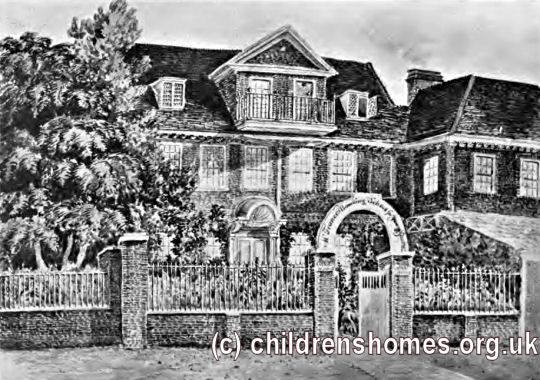School of Discipline for Girls, Chelsea, London
The House of Discipline and School of Reform for Girls (later known as the School of Discipline) was founded in 1825 by group who leading figure was the prison reformer, Elizabeth Fry. The aim of the establishment was "arresting the progress of vice in the minds of female children already contaminated by actual guilt". "Female children of vicious habits" were to be placed under "strict discipline and wholesome restraint... to correct them in their evil ways." The girls were placed under the care of a schoolmistress and instructed in the holy scriptures, reading, spelling, needlework, and household labour. The institution took over a property known as Ormonde House at 2 Paradise Row, Chelsea. (Paradise Row was renamed Queen's Road West in the 1860s, and is now known as Royal Hospital Road.)

2 Paradise Row, date unknown. © Peter Higginbotham
On June 9th, 1856, the School was officially certified as a Reformatory with accommodation for 46 girls. As well as now taking girls placed by the courts, it continued to take voluntary admissions. The matron in 1858 was Mrs Johnson. In that year, the School's government inspector noted that "the school is so efficiently conducted, is under such good superintendence, is so economical in its management, and so successful in its results that I greatly regret to find that the managers are about to give up their certificate under the Youthful Offenders Act, and to continue their admissions to free or unsentenced cases." Since the bulk of the School's inmates were in the latter category, it would receive much greater financial assistance from the grants made to uncertified schools by the Committee of Council than the allowance for maintenance provided by the Home Office.
On July 9th, 1859, the establishment was re-certified as an Industrial School for 42 girls, aged from 8 to 13 at their date of admission.
Miss Cadham was appointed matron in 1862, a post she held until 1876. She was succeeded by Miss Simon who, for a while, was assisted by her sister as schoolmistress. The industrial training included sewing, knitting, cooking, laundry and housework. In 1879, it was noted that there had been a decline in the number of girls committed to the School by magistrates.
The School maintained a generally good reputation with its inspectors although there were occasional complaints. In 1877, the schoolroom was described as being far too small. In 1883, it was suggested that the amount of punishment being administered was excessive. In 1884 the laundry, baths and lavatory were in want of improvement, and the safety of the dormitories in case of fire was questioned. By October, 1885, a fire escape for the dormitories had been fitted. The previous month there had been a fire in the laundry after some of the things which were drying had fallen into a stove. Fortunately, two fire engines arrived within four minutes of the fire alarm being rung.
In 1885, Miss Seager had become superintendent, having previously held the post of schoolteacher. She resigned in February, 1886, and was succeeded by Miss Lemmon.
In 1889, it was decided that the School buildings, described by an inspector as 'never very convenient or commodious', had outlived their useful purpose. In March, 1890, the School moved to larger premises at Parson's Green.
The old Paradise Row buildings were demolished in 1906.
Records
Note: many repositories impose a closure period of up to 100 years for records identifying individuals. Before travelling a long distance, always check that the records you want to consult will be available.
- None identfied at present — any information welcome.
Census
Bibliography
- Carpenter, Mary Reformatory Schools, for the Children of the Perishing and Dangerous Classes, and for Juvenile Offenders (1851, General Books; various reprints available)
- Carlebach, Julius Caring for Children in Trouble (1970, Routledge & Kegan Paul)
- Higginbotham, Peter Children's Homes: A History of Institutional Care for Britain's Young (2017, Pen & Sword)
- Abel Smith, Doroth Crouchfield: A History of the Herts Training School 1857-1982 (2008, Able Publishing)
- Garnett, Emmeline Juvenile offenders in Victorian Lancashire: W J Garnnett and the Bleasdale Reformatory (2008, Regional Heritage Centre, Lancaster University)
- Hicks, J.D. The Yorkshire Catholic Reformatory, Market Weighton (1996, East Yorkshire Local History Society)
- Slocombe, Ivor Wiltshire Reformatory for Boys, Warminster, 1856-1924 (2005, Hobnob Press)
- Duckworth, J.S. The Hardwicke Reformatory School, Gloucestershire (in Transactions of the Bristol and Gloucestershire Archaeological Society, 1995, Vol. 113, 151-165)
Links
- Red Lodge Museum, Bristol — a former girls' reformatory.
Except where indicated, this page () © Peter Higginbotham. Contents may not be reproduced without permission.


